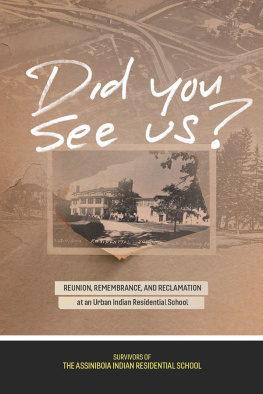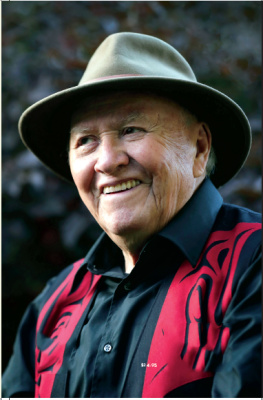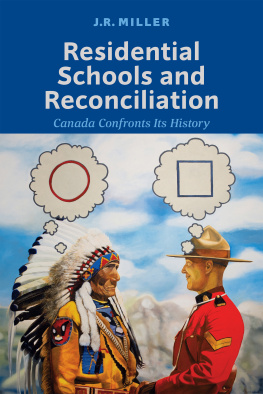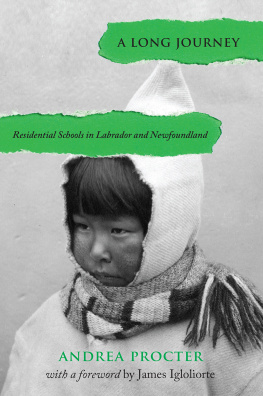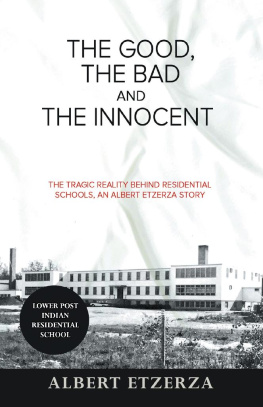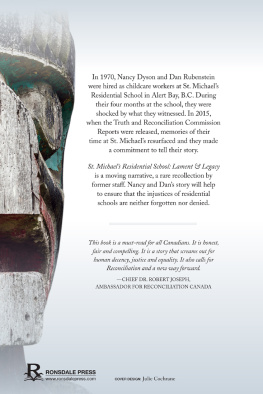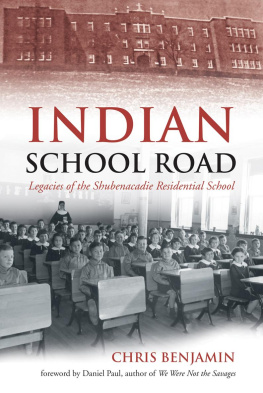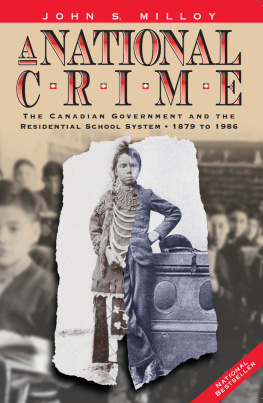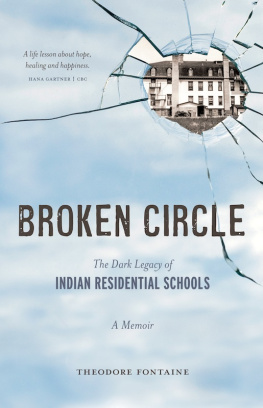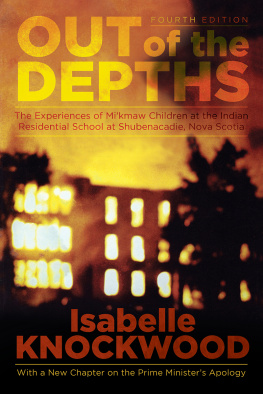Perceptions On Truth And Reconciliation
ISSN 2371-347X
5 Did You See Us? Reunion, Remembrance, and Reclamation at an Urban Indian Residential School, by Survivors of the Assiniboia Indian Residential School
4 Sharing the Land, Sharing a Future: The Legacy of the Royal Commission on Aboriginal Peoples, edited by Katherine Graham and David Newhouse
3 Decolonizing Discipline: Children, Corporal Punishment, Christian Theologies, and Reconciliation, edited by Valerie E. Michaelson and Joan E. Durrant
2 Pathways of Reconciliation: Indigenous and Settler Approaches to Implementing the TRCs Calls to Action, edited by Aimee Craft and Paulette Regan
1 A Knock on the Door: The Essential History of Residential Schools from the Truth and Reconciliation Commission of Canada, with a foreword by Phil Fontaine
Reunion, Remembrance, and Reclamation
at an Urban Indian Residential School
Survivors of
the Assiniboia Indian Residential School
Did You See Us?: Reunion, Remembrance, and Reclamation at an Urban Indian Residential School
Assiniboia Residential School Legacy Group 2021
25 24 23 22 21 1 2 3 4 5
All rights reserved. No part of this publication may be reproduced or transmitted in any form or by any means, or stored in a database and retrieval system in Canada, without the prior written permission of the publisher, or, in the case of photocopying or any other reprographic copying, a licence from Access Copyright, www.accesscopyright.ca, 1-800-893-5777.
University of Manitoba Press
Winnipeg, Manitoba, Canada
Treaty 1 Territory
uofmpress.ca
Cataloguing data available from Library and Archives Canada
Perceptions on Truth and Reconciliation, ISSN 2371-347X ; 5
ISBN 978-0-88755-907-5 (paper)
ISBN 978-0-88755-924-2 (pdf)
ISBN 978-0-88755-920-4 (epub)
ISBN 978-0-88755-925-9 (bound)
Cover and interior design by Vincent Design Residential School in Citys Backyard, by Catherine Mitchell, is reprinted with permission of Winnipeg Free Press.
Printed in Canada
This book has been published with the help of a grant from the Federation for the Humanities and Social Sciences, through the Awards to Scholarly Publications Program, using funds provided by the Social Sciences and Humanities Research Council of Canada.
The University of Manitoba Press acknowledges the financial support for its publication program provided by the Government of Canada through the Canada Book Fund, the Canada Council for the Arts, the Manitoba Department of Sport, Culture, and Heritage, the Manitoba Arts Council, and the Manitoba Book Publishing Tax Credit.
Land Acknowledgement
We acknowledge we are on First Nations land, Turtle Island, inhabited by First Nations from time immemorial.
For thousands of years, First Nations peoplethe Anishinaabe, Cree, Dakota, Dene, and Anishininew Nationswalked and lived on this land and knew it to be the centre of their lives and spirituality.
The Anishinaabe call this land Manitou Ahbee, the place where the Creator resides.
We acknowledge this became the homeland of the Mtis people.
We acknowledge and welcome the many people from countries all over the world who have come to join us, Turtle Islands First Nations, in calling this land our home.
We acknowledge we are now all bound together by Treaty 1.
Theodore Fontaine
Contents
We All Got Along and Treated Each Other
With Kindness and Respect
Dorothy-Ann Crate
Assiniboia Was a Place of Hope for Us...
But It Was Still a Residential School
Theodore Fontaine
Jane Glennon
Caroline Perreault
Valerie T. Mainville
Mabel Horton
David Montana Wesley
Hubert (Gilbert) Hart
Betty Ross
Carole Starr
Martina Fisher
The Archive Remembers:
Reading an Institutions Memory
Andrew Woolford
I Loved the Students Like They Were My
Kid Brothers and Sisters
Sister Jean Ell
Luc Marchildon
Gary Robson
Patricia Holbrow
Morgan Sizeland Fontaine
Assiniboia Residential School
Interpretive Panel Project
Murray Peterson
Aila Potosky
Lianna McDonald
Catherine Mitchell
Andrew Woolford
Theodore Fontaine
Illustrations
Dedication
Survivors of the Assiniboia Indian Residential School have shared powerful remembrances at our reunions and meetings and through the compilation of our stories in this commemorative book.
It is important to understand the meaning of the word story. In English, a story must be clarified as to whether its fictional or non-fictional. There isnt that distinction in the Anishinaabe language. You speak as if you were holding an eagle feather or had your hand on the Bible. Your word is your word and your story is truth. I would like to acknowledge and attribute this teaching to Roger Roulette, a renowned expert in the Ojibwe language.
Children from more than eighty First Nations and other Indigenous communities attended Assiniboia. The first students came from First Nations in Manitoba. Slowly, students from Alberta, Saskatchewan, Ontario, and Quebec became part of the Assiniboia community. Those who survived genocide and violence while incarcerated in their first Indian residential schools became leaders in the evolution of the Indian residential schools system. Transition to life at Assiniboia brought us into a comfortable and safe urban environment. We are grateful to Reverend Father Omer Robidoux, Assiniboias principal, whose grace and leadership brought us individually and collectively to a better place.
This evolution is a testament to the adaptability of Indian children to survive colonization policies put into practice by governments, churches, and Indian residential school administrators. Yet approximately 60 to 70 percent of the former 600 students of Assiniboia departed this earth early. We miss them, and now, in our private moments, we relive the stories of the joy, love, and friendship we shared with those now departed from our realm.
We remember all of our departed schoolmates, too numerous to list, but never forgotten. We remember the first graduates of Assiniboia, Oliver Nelson and Joe Guy Wood, and the many who followed through different eras, including wonderful singer and performer Percy Tuesday; smooth skater Joe Malcolm; gracious Alma Patrick; the Burns sisters from KeeSee; storyteller Dennis Fontaine and all those from Sagkeeng; the Wood and Harper clans from the Island Lake area; the Nepinaks of Pine Creek; and our friends from Norway House, Gods Lake, Gods River, Cross Lake, Deer Lake, Roseau River, Eagle Lake, Couchiching, Sandy Lake, and many other communities.
Those who are gone have left their presence in our hearts. Their footsteps are indelible impressions in the grassy playing fields and on the wooden floors of our classrooms building. We hold their memories sacred. They are with us when we are on the grounds of Assiniboia, their spirits ever-present in our lives.

